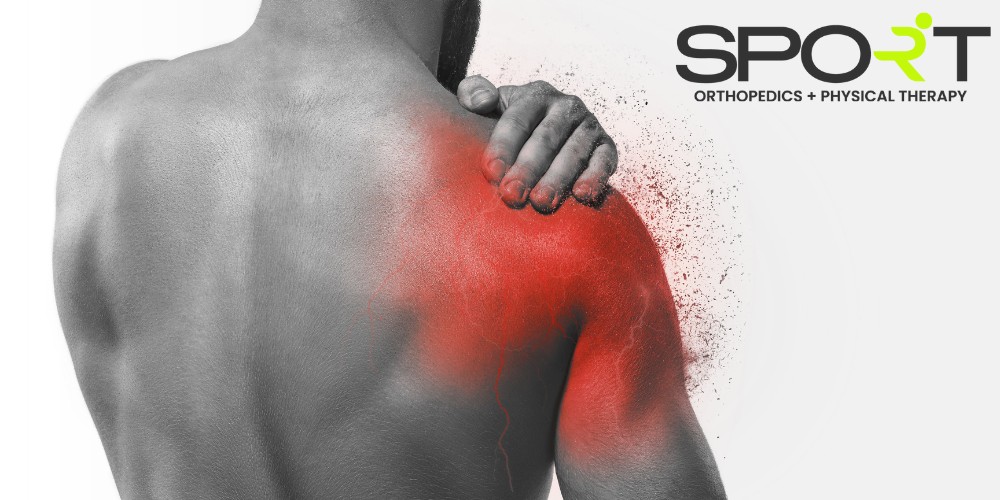
When someone has pain in a specific part of their shoulder, they’re likely to search online for the cause before seeing a doctor. By using a shoulder pain diagnosis chart, patients can get a better understanding of what affects certain parts of the shoulder. The shoulder joint is both important and complex, which makes it difficult to determine the source of pain without a proper medical examination.
If you suffer from shoulder pain that impacts your daily life, it’s time to stop hurting and start living. The team at SPORT Orthopedics + Physical Therapy is here to evaluate and diagnose the source of your pain, then provide swift care to get you back in the game in no time. To schedule an appointment with a top Dallas orthopedic surgeon, please call us at 469-200-2832 today.
We offer surgical and nonsurgical solutions, on-site physical therapy and imaging, Saturday hours, and orthopedic urgent care in Dallas, Frisco, Prosper, and Wylie.

As we mentioned before, the shoulder joint is highly complex, with many different moving parts that could suffer injuries or develop painful conditions. The best way to find the source of your pain is to speak with an experienced orthopedic doctor. We can evaluate your symptoms, perform imaging tests, and gather other information to diagnose your pain.
Some of the most common causes of shoulder pain include rotator cuff tears, frozen shoulder, shoulder dislocation, rotator cuff tendinitis, clavicle fracture, shoulder separation, and other shoulder problems. Many other conditions and injuries can lead to shoulder pain as well, many of which require swift diagnosis and treatment.
Your orthopedic doctor will perform a very thorough evaluation of your shoulder after you seek medical care. Certain tests and examinations help them get a diagnosis for your shoulder pain, which they can then create a treatment plan for.
Most doctors will begin by taking a medical history, which can give them insight into when your pain started and your general health. Then, they will proceed with a physical examination. Orthopedists look for swelling, deformities, muscle weakness, tender areas, and physical irregularities. They will also test your joint for its range of motion and strength.
If necessary, your doctor may also run more specific tests to help pin down the source of your shoulder pain. Some of these tests include the following.
Using the above tests and exams, your doctor may diagnose you with one of the following conditions or injuries.

If you feel pain around the front and side of your upper arm and shoulder, you may receive a diagnosis for one of the following. Remember that this list is not exhaustive of all potential sources of pain.
Bursitis is a condition in which the bursae become inflamed. A bursa is a fluid-filled sac that helps cushion the bones, muscles, and tendons in the joints. When this condition affects the shoulder joint, it is known as shoulder bursitis.
The clavicle is the thin bone that spans between the shoulder blade and the sternum. If someone suffers a clavicle injury, such as a clavicle fracture, this can cause pain anywhere along the length of the collarbone. Because of its relative fragility, the clavicle is the most frequently broken bone in the human body. It could break during a fall or a car accident, or it could be weakened to the point of breaking by distal clavicle osteolysis or bone infections.
When someone injures the cartilage of the inner part of the shoulder joint, this is referred to as a SLAP injury. SLAP stands for Superior Labrum Anterior and Posterior. When only one part (anterior or posterior) is injured, it is called a SLAP injury. When both parts (anterior and posterior) are injured, it is called a SLAP tear. Many of these injuries are caused by a bad fall or repetitive overhead motions.
When the bottom part of the labrum in the shoulder suffers a tear, this is known as a Bankart lesion. The labrum is the ring of cartilage that lines the shoulder socket. It occurs most often during a shoulder dislocation. The recommended surgical treatment is known as a Bankart repair, which helps with shoulder instability.
Also called adhesive capsulitis, frozen shoulder involves the inflammation of the tissue surrounding the shoulder joint. Most cases of frozen shoulder start with shoulder pain, then progress to the point of noticeably restricted shoulder movement. The longer someone waits to seek treatment, the worse the restrictions will get and the longer it will take to recover.
Also known as shoulder impingement syndrome, this condition results from one or more structures in the shoulder joint being compressed between the bones in the shoulder. It usually occurs gradually, with the most common symptoms being weakness and painful movements. This is one of the most common sources of shoulder pain.
The rotator cuff is a group of tendons and muscles in the shoulder that help keep the head of the upper arm bone in its place in the shoulder socket. Four tendons help to ensure stability and functionality of the shoulder. Most rotator cuff tears result from repetitive motions, but they can also occur from a sudden fall or from lifting heavy weights. When the rotator cuff muscles or tendons are torn, this constitutes a rotator cuff tear.
When the tendons around the biceps become inflamed and painful, this is called biceps tendonitis. Although the pain is usually worse with overhead motions, applying pressure to the affected tendon can also produce pain. You may also feel or hear snapping when you move your arm.
A midshaft humerus fracture could also cause significant shoulder pain. In younger patients, a healthy humerus is difficult to break, which means they must endure great force. In older patients, a simple fall could result in a fractured humerus. Midshaft fractures can cause severe pain, and they often require prompt medical treatment.

If you feel pain around the back of your shoulder and shoulder blades, you may be diagnosed with one of the following. Again, this is not an exhaustive list of possible causes of your shoulder pain. Additionally, some conditions that affect the front of the shoulder can also affect the back of the shoulder, and vice versa.
Particularly in the upper trapezius muscle, muscle strain is a common source of shoulder pain. If you strain your muscles from sports or heavy lifting, this can cause intense pain. Even office workers may experience muscle strain if they work all day in front of a computer.
Having poor posture, such as slouching, can also cause shoulder pain. Like muscle strains, poor posture is associated with pain between the shoulder blades. It is common in office workers and tall people who tend to stoop or slouch.
This is a rare condition that involves complex patterns of pain and other symptoms. When damage occurs to the fourth thoracic vertebra or the area around it, this can lead to shoulder pain, numbness, tingling, muscle spasms, and even headaches. The pain intensifies if any pressure is applied to or around the T4 vertebrae. Symptoms also tend to get worse at night and with certain shoulder movements that affect the upper and middle back.
Fascia are thin bands of connective tissue that surround every bone, organ, nerve, muscle, and blood vessel in place. When the bands of fascia tighten and cause pain at a specific point, these are known as trigger points. They are very sensitive to pressure and often cause dull, aching pain. Trigger point injections are the most common treatment for this condition.
Also called Scapulothoracic Bursitis, snapping scapula syndrome is one of the rarer causes of shoulder pain. The shoulder blades are supposed to move over the rib cage smoothly, but this condition causes a snapping or grinding sensation when moving the arms. This happens when there is an issue with how the shoulder blade moves over the ribs. It can cause a constant aching feeling in the shoulder.
Although not the most common of fractures, shoulder blade (scapula) fractures can occur when great force is applied to the bone. Because scapular fractures are often associated with rib and spinal fractures, patients may experience both shoulder and chest pain. Car accidents and falling from heights are usually the cause of scapular fractures.
Dislocations of the shoulder joint occur when the head of the humerus comes out of the shoulder socket. This particular shoulder injury could be a partial or full dislocation. Putting the shoulder back in place can relieve pain and improve the shoulder's range of motion.
Arthritis is a kind of inflammation that affects the joints in the body. Shoulder arthritis can cause shoulder pain, stiffness, and a loss of range of motion. It often results from deterioration or damage to the cartilage in the shoulder.

Depending on your diagnosis and its severity, your orthopedic doctor will develop a personalized treatment to target your problem areas. Some cases of shoulder pain are very mild and temporary, while others will not improve without treatment. The most common treatment options for shoulder pain include the following.
Over-the-counter medications may help patients with mild pain, but severe pain may not respond to them. In this case, prescription medications or shoulder injections may be the only non-surgical options for relieving serious shoulder pain.
Many conditions that cause shoulder pain can be treated or alleviated through physical therapy. Your physical therapist will help you strengthen the muscles, tendons, and ligaments in your shoulder. You can also improve your range of motion and alleviate shoulder pain through physical therapy. Over time, you may even be able to restore full function to your shoulder.
Certain more severe shoulder problems may require surgery to treat or repair. Most patients respond well to medication and physical therapy, but not every condition will improve with conservative treatments. Examples of conditions that may require surgery include recurrent shoulder dislocations, rotator cuff tears, fractures, and bone spurs.
Shoulder arthroscopy is the preferred surgical technique, as it causes minimal damage to the shoulder tissues and an easier recovery period. If a large-scale repair or shoulder replacement is needed, the surgeon may opt for traditional open surgery.

Although not every shoulder injury or condition can be prevented with lifestyle changes, some can be managed or prevented in the following ways.
If you are experiencing shoulder pain and nothing seems to help, the orthopedic specialists at SPORT Orthopedics + Physical Therapy can help. We offer a wide range of shoulder pain treatments, both surgical and nonsurgical. Whether you injured your shoulder in a motor vehicle accident, in a sports game, or after repetitive motions and stress, we have options for you. Our shoulder pain diagnosis chart is a good place to start, but we always recommend seeking medical attention for your pain. To schedule an appointment with one of our qualified professionals about your shoulder pain, please call our office at 469-200-2832 today.









*We accept most all insurance plans, if you do not see your plan listed above or have any questions, please contact our office.

SPORT Orthopedics + Physical
Therapy – Dallas, TX
Services:
• Clinic • Orthopedic • Urgent Care
• Physical Therapy
18152 Preston Road
Suite I-2
Dallas, TX 75252
Phone: (469) 200-2832
Fax: (469) 269-1074
SPORT Orthopedics + Physical Therapy – Frisco, TX
Services:
• Clinic • Orthopedic • Urgent Care
• Physical Therapy
9255 Dallas Parkway
Suite I20
Frisco, TX 75033
Phone: (469) 200-2832
Fax: (469) 269-1074
SPORT Orthopedics + Physical
Therapy – Wylie, TX
Services:
• Clinic • Orthopedic • Urgent Care
• Physical Therapy
3400 FM 544
Suite 650
Wylie, TX 75098
Phone: (469) 200-2832
Fax: (469) 269-1074
SPORT Physical
Therapy – Prosper, TX
Services:
• Physical Therapy
790 N Preston Rd
Suite 60
Prosper, TX 75078
Phone: (469) 850-0201
Fax: (469) 269-1074
SPORT Orthopedics – Mesquite, TX
Services:
• Clinic
• Orthopedic
• Urgent Care
1102 North Galloway Ave
Mesquite, TX 75149
Phone: (469) 200-2832
Fax: (469) 269-1074